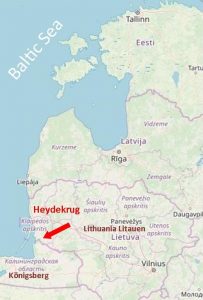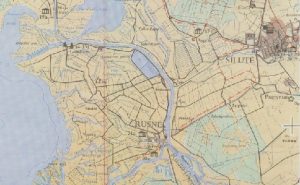About the district of Heydekrug from the 19th century up till 1919 (Separation from Germany).

Since 1511 Heydekrug is referred to by a document from the commander of the Teutonic order from Memel. Within the administrative reforms of Friedrich Wihelm the city received a seat in the regional office. Since 1815 it was the seat of the chief administrative office of the district as well as the economic centre of the region. The market area, located on the Sziesze, was able to exhibit a brickwork and a steam mill in the 19th century. It is worth mentioning its fish and pork industries. The number of inhabitants grew form 348 (1871) to 415 (1898). Today this town belongs to Lithuania and is called Silute.
Russ is a village of the same name as the northern estuary of the Memel. About 1336 a house for a German (religious) order is mentioned on the southern bank of the river. Since 1498 the village inn is recorded. Salmon fishing, timber trade and shipping were carried on in the village. The number of inhabitants grew from 1952 (1871) to 2120(1898). Today the village lies on the boarder between Lithuania and area of Kaliningrad and is called Rusne.
The situation of the Jews in Russ is reported in the memoirs of the country doctor, by Arthur Kittel. >>
On the basis of the documents from the synagogue, information for the Jewish school children and documents about immigration and migration a databank can be established for the area through facts about settling, size of family and migration, etc. (Since a databank already has been set up for the district of Fischhausen, an area southwest of Königsberg, a comparison can be made within the region, whereby, among other things, the influence of the boarder should be discussed.)
The network of relations between Jews on both sides of the boarder has not yet been researched to date. There was to be sure considerable activity primarily for commercial reasons. At the same time the numerous visits of Jewish merchants to Tilsit can be counted . Another issue focuses on the migration across the boarder- legal immigrants as well as unauthorised visits-and the restrictions of the Prussian administrators concerning these issues.
All of the immigrants from 1886-1902 can be named for the district of Heydekrug as well as the reaction of the Prussian administrators who either chose to give an order of expulsion or granted a limited visitors permit whereby restrictions were also included. Likewise the acquisition of German citizenship is recorded.

It is noticable that immigrants are primarily Jews who come from Zemaitija, the neighbouring West Lithuania-thus a migration of a short distance. (Moreover there are similarly other immigrant groups in the same time period whose relation to the Jewish immigrants should be similarly explained.)
Undoubtedly this migration also had an influence on family relations. For the district of Heydekrug there are documents for all of the marriages from 1848-1872 from which we can see not only that about 50% the resident Jewish citizens at the time entered marriages with women who did not possess Prussian nationality (they came from, among other countries, Latvia, Lithuania and Poland). The official notice of intended marriage, character references and other pieces of writing provide us with a good view of how much paper and bureaucratic effort was necessary for a Jewish marriage in Prussia.

Communities with synagogues existed on the boarder districts in which there was for the most part only a synagogue and a rabbi. The distance between towns was significant so that there was a lack of religious instruction for Jewish children. In some cases it has been documented that children were given instruction by a Rabbi from Lithuania; in another case 50 poor families in the district Ragnit invited a teacher from Kaunas who was expelled soon after by German officials. The size of the community fluctuated, because there was constantly an influx from the other side of the boarder and migration to the interior of the country.
Heydekrug was a typical district with many small villages. Information about where Jews lived can be found on the page Statistics.
For the community of Heydekrug and Russ there are financial records as well. With the help of these sources one can draw some conclusions concerning the economic situation of the members of the community.
Translation from German by Mark Lekarew
Go to directory Places in East Prussia A-Z >>
